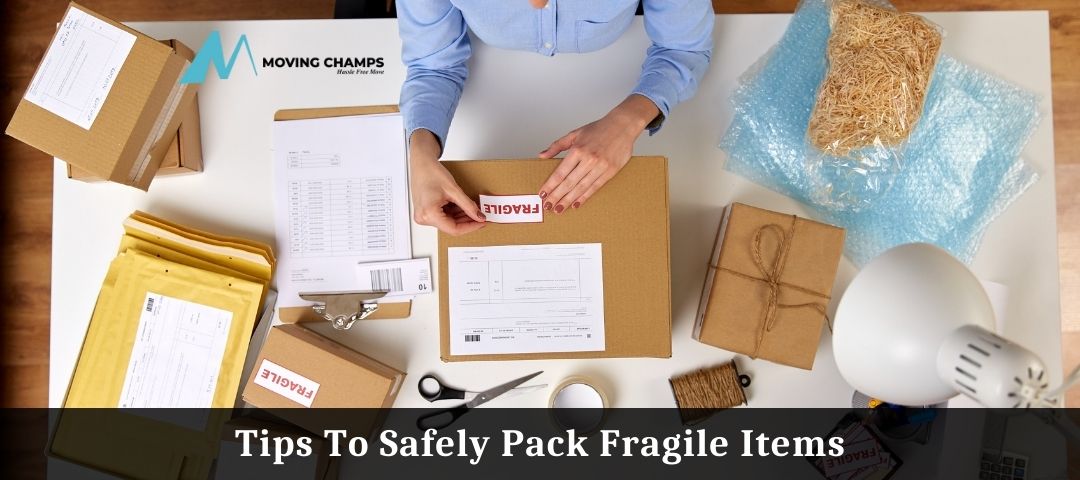Are you preparing for a house move and feeling nervous about packing fragile items? Safely packing delicate belongings is crucial to ensure they arrive at your new destination in pristine condition. With the right packing techniques and attention to detail, you can protect your fragile items during the moving process.
To help you with packing delicate belongings, Moving Champs Canada has gathered invaluable packing tips for fragile items. In this blog, we will share expert advice on how to pack fragile items for your upcoming move safely. Whether it’s delicate glassware, fine china, or fragile electronics, these packing tips will help you ensure a smooth and worry-free relocation. So let’s find the best practices for packing your fragile items securely.
10 Essential Tips To Pack Fragile Items
Fragile item moving raises many challenges. So, here are some experts tips on how to pack fragile items so that they are relocated to your new place in perfect condition without any scratches:
1. Gather The Necessary Supplies
Before you begin packing your fragile items, it’s important to gather all the necessary supplies to ensure a smooth and efficient process. Here’s a detailed explanation of the required materials:
- Sturdy Boxes: Opt for boxes of various sizes to accommodate different types of fragile items. Ensure they are in good condition and can withstand the weight and handling during the move.
- Bubble Wrap: This versatile packaging material provides excellent cushioning and protection. Wrap each fragile item individually with several layers of bubble wrap to guard against impacts.
- Packing Paper Or Tissue Paper: Use packing paper or tissue paper to wrap delicate items that are susceptible to scratches or abrasions. It provides an additional layer of protection.
- Packing Peanuts Or Foam Padding: These materials act as cushioning inside the boxes, filling up empty spaces and preventing items from shifting during transit. They offer extra protection against vibrations and shocks.
- Packing Tape: Choose a strong and wide packing tape to seal the boxes securely. It should be able to withstand the rigours of transportation.
- Marker Pens: Use marker pens to label the boxes and indicate their contents. This makes it easier to identify fragile items and handle them with care during the move.
- Fragile Stickers or Tape: Attach “Fragile” stickers or fragile-specific tape to boxes containing delicate items. This alerts movers and yourself to exercise caution when handling these boxes.
By ensuring you have all these packing supplies, you’ll be well-prepared to protect your fragile items during the moving process.
2. Create A Packing Plan
Having a well-organized packing plan is crucial for effectively and safely packing your fragile items. Follow these steps to create an efficient plan for packing your fragile items:
- Step 1: Sort And Declutter: Before you start packing, go through your belongings and sort them. Determine which fragile items you want to keep, donate, or dispose of. Decluttering reduces the number of items to pack, making the process more manageable.
- Step 2: Categorize And Prioritize: Group similar fragile items together based on their material, shape, or size. This helps you pack them more efficiently and ensures they receive the appropriate level of care. For example, pack glassware together, electronics together, and so on.
- Step 3: Start With Less Fragile Items: When you begin packing, start with items that are less fragile and require less care, such as sturdy kitchenware or books. This allows you to practice and build your confidence before moving on to more delicate items.
By following a packing plan, you can stay organized, save time, and ensure that each fragile item receives the necessary attention during the packing process.
3. Wrap Items Individually
To safeguard your fragile items from bumps, scratches, and other potential damage during transportation, it’s crucial to wrap each item individually. Follow these steps to pack fragile items properly:
- Step 1: Clean And Dry: Before wrapping, ensure that the items are clean and dry because dust or moisture can potentially cause damage during transit.
- Step 2: Use Bubble Wrap Or Packing Paper: Start by wrapping each fragile item with several layers of bubble wrap or packing paper. Begin by wrapping the item loosely and secure the wrap with tape. Pay extra attention to delicate parts, such as handles, spouts, or protruding elements.
- Step 3: Fill Empty Spaces: Fill any empty spaces inside the box with packing peanuts, crumpled paper, or foam padding. This provides cushioning and prevents items from shifting during the move.
By individually wrapping your fragile items, you create an extra layer of protection and minimize the risk of damage caused by collisions or friction.
4. Choose Appropriate Boxes
Selecting the right boxes is essential for packing your fragile items safely. By choosing the right boxes, you provide a solid foundation for the safe transportation of your fragile items. Here are some key considerations:
Size:
- Choose boxes that are appropriate in size for packing your fragile items.
- Avoid overpacking or underpacking the boxes.
- Ensure there is enough space to add cushioning material while also
- preventing excessive movement of the items inside.
Durability: Opt for sturdy, double-walled boxes to pack fragile items that can withstand the weight and provide adequate protection. Boxes designed specifically for fragile items or electronic equipment may offer added reinforcement.
Bottom Reinforcement: Before packing, reinforce the bottom of each box with packing tape. This helps prevent the box from giving way under the weight of the items during transit.
5. Pack Boxes Carefully
When it’s time to pack fragile items individually into the boxes, follow these tips for maximum protection:
- Step 1: Layering: Start by placing a layer of packing peanuts or crumpled paper at the bottom of the box. This acts as a cushioning layer and absorbs shocks.
- Step 2: Positioning: Place the wrapped fragile items in the box one by one, ensuring they are snugly packed. Avoid leaving any empty spaces or gaps between the items. This prevents them from shifting and colliding during transportation.
- Step 3: Separation: Separate each fragile item with additional layers of packing paper or bubble wrap. This adds an extra barrier of protection and reduces the risk of damage caused by friction or direct contact.
6. Use Proper Cushioning Material
To provide additional protection for your fragile items, it’s important to use proper cushioning material. In addition to packing peanuts or crumpled paper, you can consider using foam padding, air-filled plastic wrap, or foam pouches. These materials offer extra shock absorption and help safeguard your delicate belongings during the moving process.
Properly wrapping fragile items with cushioning material helps minimize the risk of damage caused by vibrations or accidental impacts. Remember to fill any gaps or voids inside the boxes to ensure the items remain securely in place.
7. Pay Attention To Weight Distribution
Maintaining proper weight distribution within your packed boxes is crucial for the safety of your fragile items. Distribute the weight evenly by placing heavier items at the bottom and lighter ones on top. This prevents excessive pressure on delicate items and minimizes the risk of crushing or shifting during transportation.
Consider the weight and fragility of each item as you pack. If necessary, use additional cushioning material or dividers to create separate compartments within the box, ensuring that fragile items are isolated and protected from potential damage.
8. Secure Boxes With Strong Tape
After packing your fragile items, it’s essential to seal the boxes securely to prevent any accidental openings. Use high-quality packing tape that is wide and strong enough to withstand the weight and handling during the move. Apply several strips of tape across the top and bottom seams of the box to reinforce its integrity.
Additionally, for added precaution, consider reinforcing the corners and edges of the boxes with extra tape. This will provide additional strength and stability, minimizing the risk of the boxes breaking open or collapsing during transit.
9. Label And Handle With Care
Proper labelling is crucial to ensure that your fragile items are handled with care throughout the moving process. By labelling and communicating clearly, you ensure that your fragile items receive the special care they need during the moving process. Follow these labelling and handling tips:
Step 1: Label As Fragile: Clearly label each box containing fragile items with a “Fragile” sticker or fragile-specific packing tape. This alerts us to exercise caution when handling these boxes.
Step 2: Directional Arrows: Use directional arrows on the box to indicate the correct upright position. This helps prevent mishandling or stacking heavy items on top of delicate ones.
Step 3: Communicate With Movers: If you’re hiring professional movers, such as Moving Champs Canada, inform them about the boxes containing fragile items. Provide any specific instructions or concerns you may have regarding the handling of these boxes.
10. Consider Professional Packing Services
For highly delicate or valuable items that require extra care, it’s worth considering professional packing services. Expert packers have the experience, knowledge, and specialized materials to pack fragile items with the utmost care and ensure their safe transportation.
Professional packers like Moving Champs Canada are trained to pack fragile items securely, using the appropriate techniques and materials. We can provide custom packaging solutions tailored to your specific items, offering an added layer of protection and peace of mind.
Conclusion
By following these expert fragile item packing tips and techniques, you can safely pack your fragile items and minimize the risk of damage. Moving Champs Canada has provided these valuable tips to ensure your fragile items are packed with precision for their undamaged relocation. By taking these necessary precautions, you can start your move confidently, assured that your delicate belongings will arrive at your new residence without damage and can be enjoyed immediately.
If your space has more fragile items, consider reaching out to Moving Champs Canada for assistance with packing your fragile items. Our expertise ensures your delicate belongings are packed meticulously for a smooth and secure relocation. By considering our professional packing services in Canada, you can entrust your fragile items to our experts, who will handle them with precision and care. So call us today at +1-6479322202 or mail your query to info@movingchamps.ca to book our movers and packers Canada team.
Related Blogs
How To Organize A Home Library
In the digital age, where information is increasingly consumed through screens and devices, the allure of a physical book remains as captivating as ever. For bibliophiles and avid readers, their cozy home library is more than just repositories of knowledge; they are...
8 Factors That Influence Your Cost Of Moving
We are aware of how much you cherish your possessions and how much they mean to you. However, when you have to move to a different site, a problem occurs. Shipping a car or home items may be expensive and time-consuming. The cost of moving home goods is not fixed and...
Tips To Childproof A Home On A Moving Day
The moment you have been waiting for so long has finally arrived – moving day! While you may feel excited about the progress you've made in preparing for the move, it's essential to prioritize your child's safety on this big day. Amidst the excitement, one needs to...




